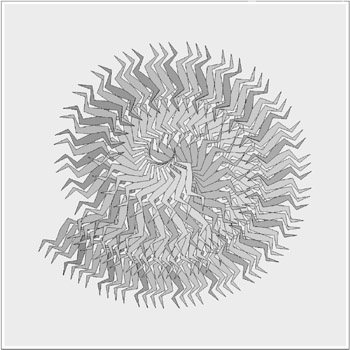Chapter 8: Syntactic Extension
Overview

A warped, two-armed spiral.
Syntactic extensions, or macros, are used to simplify and regularize repeated patterns in a program, to introduce syntactic forms with new evaluation rules, and to perform transformations that help make programs more efficient.
A syntactic extension typically takes the form (keyword subform …), where keyword is the identifier that names the syntactic extension. The syntax of each subform varies from one syntactic extension to another. Syntactic extensions can also take the form of improper lists (or even singleton identifiers; see Section 8.3), although this is less common.
New syntactic extensions are defined by associating keywords with transformation procedures, or transformers. Syntactic extensions are defined globally using top-level define-syntax forms or within the scope of particular expressions using let-syntax, letrec-syntax, and internal define-syntax. Transformers are created using syntax-rules or syntax-case, which allow transformations to be specified via pattern matching.
Syntactic extensions are expanded into core forms at the start of evaluation (before compilation or interpretation) by a syntax expander. The expander is invoked once for each top-level form in a program. If the expander encounters a syntactic extension, it invokes the associated transformer to expand the syntactic extension, then repeats the expansion process for the form returned by the transformer. If the expander encounters a core syntactic form, it recursively processes the subforms, if any, and reconstructs the form from the expanded subforms. Information about identifier bindings is maintained during expansion to enforce lexical scoping for variables and keywords.
The syntactic extension mechanisms described in this chapter are part of the "syntax-case" system that has become a de facto standard in the absence of a standard full-featured syntactic extension system. A portable implementation of the syntax-case system is available at http://www.scheme.com/syntax-case/. The syntax-case system also supports modules and several other features that are described in the Chez Scheme User's Guide [5]. A description of the motivations behind and implementation of the system can be found in the articles "Syntactic Abstraction in Scheme" [7] and "Extending the Scope of Syntactic Abstraction" [22].
The Revised5 Report includes only let-syntax, letrec-syntax, top-level define-syntax, and syntax-rules. The pattern language supported by the Revised5 Report version of syntax-rules is also more limited, with pattern ellipses allowed only at the end of list- or vector-structured patterns. (See page 187.) Furthermore, the bodies of let-syntax and letrec-syntax are treated like lambda bodies, i.e., they open up new scopes, which prevents them from being used in contexts where definitions are required. (See page 185.) Programmers desiring to write programs that are guaranteed to run to all Revised5 Report implementations should stick with the Revised5 Report subset and use let-syntax and letrec-syntax in a manner consistent with either interpretation. The ANSI/IEEE standard does not include any syntactic extension mechanism.
EAN: 2147483647
Pages: 98